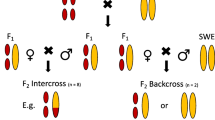Summary
Females of two parapatric chromosomal forms (2n=52 and 2n=58) of the fossorial mole rat,Spalax ehrenbergi, in Israel, were tested for mate selection between two alternative, a homo- and a heterochromosomal, males. Estrous females significantly preferred the male of their own chromosomal form, on the basis of several behavioural criteria. The evolutionary significance of the positive assortative mating found, lies presumably in reinforcing reproductive isolation between the chromosome forms, thereby contributing to finalize speciation.
Similar content being viewed by others
References
E. Mayr, inPopulations, Species and Evolution (Belknap Press, Harvard University, Cambridge, Mass. 1970).
E. Nevo, Nato Adv. Study Inst. Vertebrate Evolution, Istanbul (1969).
E. Nevo, Israel J. Zool.22, 207 (1973).
E. Nevo andH. Bar-El Evolution, in press (1976).
E. Nevo, Science163, 484 (1969).
J. Wahrman, R. Goitein andE. Nevo, Science164, 82 (1969).
S. Wilks, inMathematical Statistics (John Wiley and Sons, New York 1962).
M. Hansen, W. Hurwitz andW. Madow, inSample Survey Methods and Theory, (John Wiley and Sons, New York 1953).
J. F. Crow andJ. Felsenstein, Eugen. Q.15, 85 (1968).
P. O'Donald, Nature153, 1210 (1959).
J. K. Lowether, Can. J. Zool.39, 281 (1961).
P. A. Parsons, inThe Genetic Analysis of Behaviour (Methuen, London 1967).
D. Mainardi, Inst. Lombardo (Rend. Sci.)B 97, 135 (1963).
D. Mainardi, Atti Ass. genet. ital.9, 141 (1964).
J. Yanai andG. E. McClearn, Behav. Genet.2, 173 (1972).
J. Yanai andG. E. McClearn, Behav. Genet.3, 75 (1973).
E. Nevo, M. Bodmer, G. Heth, Experientia (this issue).
E. Nevo andR. R. Capranica (in preparation).
E. Nevo, G. Naftali andR. Guttman, Proc. Nat. Acad. Sci. USA72, 3250 (1975).
Author information
Authors and Affiliations
Additional information
Acknowledgments. We thank M. Avrahami and Y. Sivan for field assistance; H. Bar-El for karyotyping the animals; Z. gilula for statistical assistance and I. Kornfield and S. Mendlinger for critically commenting on the manuscript. This study was partly supported by a Volkswagenwerk, grant No. A 3:11:1434, and an Israel National Academy of Sciences, grant No. 184 to E. Nevo.
Rights and permissions
About this article
Cite this article
Nevo, E., Heth, G. Assortative mating between chromosome forms of the mole rat,Spalax ehrenbergi. Experientia 32, 1509–1511 (1976). https://doi.org/10.1007/BF01924422
Published:
Issue Date:
DOI: https://doi.org/10.1007/BF01924422




